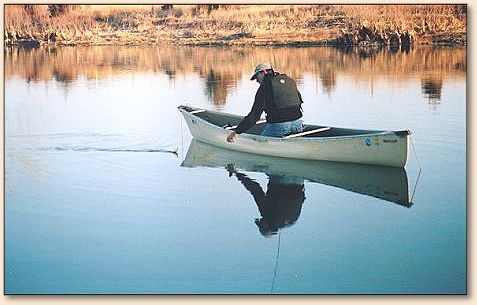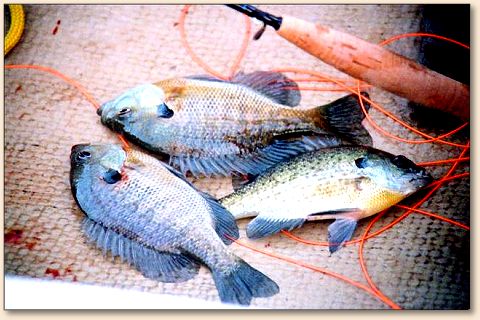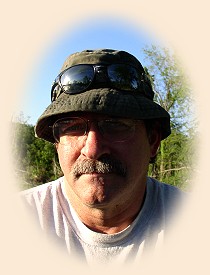|
January 15th: It was dawn and I was leaving Hastings,
Nebraska for what promised to be a long, lazy day driving
through the countryside with my friend Blanche.
Although she's lived there for four years, Hastings "newcomer"
Blanche had never done much exploring of that city's surroundings.
Which in her case is understandable: Nebraska is a fine-looking
state in many regions, but much of the area around Hastings is
so flat it makes Kansas look like the Himalayas. For someone
like Blanche, who grew up in the eastern Rockies of Montana and
Wyoming, and who lived most of her life near some of the most
famous Western trout streams, Nebraska hasn't seemed to offer
much in the way of scenic interest. I told her that the beauty
of Midwest terrain can be extremely subtle; pilgrims need time
to develop an appreciation, but once that connection is made
they're hooked for life and the Rockies start to look a bit
boring.
I knew zip about the Hastings area, so she and I would have
been clueless without a Nebraska Gazetteer I'd brought along.
Although nowhere near as detailed as USGS quadrangle topo maps,
these Gazetteers (published for every state) are certainly
detailed enough to show many interesting places that are never
seen on conventional state road maps.
Being a longtime upland game bird hunter, once we left the
Hastings city limits it depressed me to see everywhere around
us a landscape dominated by shiny center pivot irrigation piping
and "clean farming" methods so ruthlessly efficient that scarcely
any water, cover and food is left for game birds to utilize.
Nobody can call this part of Nebraska pheasant country.
Still, the state's game department does good things here. The
Gazetteer pages covering the Hastings area are dotted with
"waterfowl production areas." We didn't visit any, so I can
only guess that these WPA's are marshes built (or modified from
their natural shapes) to function as nesting habitat for ducks
and geese. I regret not looking at just one of them because,
well, you'd think that waterfowl nesting habitat also contains
enough water depth for good panfish habitat? The Gazetteer's
legend has little jumping fish logos that indicate public fishing.
The waterfowl production areas lacked this logo, so I had to
question whether public fishing is even allowed in these
state-owned prairie potholes (if that's what they are).
At any rate, days earlier I'd told Blanche that I would bring
my canoe and fly fishing gear along, and I wanted to try a few
panfish spots if we encountered any. She had her camera bag
and gear and was okay with me fishing while she did her shooting.
So Sunday morning we headed out. With my canoe racked above my
pickup cab we probably looked like a couple of confused tourists
trying to find the Missouri Ozarks.
First place we went was Harlan Reservoir. It's quite a drive
from Hastings, but was worth the trip just to see all those
mallard ducks, snow and Canada geese and bald eagles that were
there. Harlan Reservoir sits in a wide river valley surrounded
by pastureland; the scenery put me in mind of what the Mongolian
plains might look like? Very pretty with a stark, wilderness
quality, Harlan would be a fantastic lake to camp next to on a
clear, starry night during a new moon phase.
Leaving this big lake, we doubled back north toward Kearney to
check out a state park east of that city. The Gazetteer showed
a jumping fish logo there. Pulling into the place, we found a
series of small lakes arranged east/west. Each lake looked good
to me due to the presence of aquatic vegetation and numerous
blow-downs that create ambush cover for predatory fish.
I would have loved to fish any one of those lakes for the
remainder of the day, but with three or four more map
possibilities to check before sundown I turned down the
chance. Blanche had not seen any of the upcoming map lakes
and this was a joint exploration trip, so I wanted her to
see as many lakes and rivers as we could work in today.
Our next stop was Prairie Lake, located only 5 miles or so
west of Hastings. I wasn't expecting much judging from the
map location, so I was surprised and excited at how great
Prairie Lake looks. From the road its water clarity appears
excellent. Best of all, its entire shoreline perimeter offers
a mix of vegetation, submerged brush and blow-down trees.
The lake is narrow with lots of little coves, plus it sits
in a little valley. Prairie Lake would offer protected
fishing in a variety of hostile wind conditions.
However…the access road leading to the shore was chained across
and padlocked: Prairie Lake was shut down. (I learned later that
there've been problems with night-time parties and various illegal
activities.) Hopefully, this lake is drive in accessible to
fishermen come spring and throughout the summer months.
Leaving Prairie Lake, we headed farther west to check Roseland
Lake. This lake looked nice viewed from the main county road,
but once I drove closer we saw that Roseland has a serious
problem: its water is extremely muddy - so murky I doubt a fish
could find a fly if you dropped one six inches in front of its
nose.
Zipping away from Roseland Lake, we ran north to look at the
Platte River, and especially to see whether any lakes or ponds
lay in that river's broad valley. Minutes after crossing the
Platte, we came upon Interstate 80 and took it back east. At
the Woods River exit we crossed back north over the Interstate
and scoped out Cheyenne State Recreation Area. This fish logo
recreation area is actually a "borrow pit" - an area of floodplain
that years ago was surface mined with the extracted soil used
to build up the elevation of Interstate 80's roadway during
construction.
Borrow pits typically are crude affairs -- the strip mining
activity involves no special effort to leave behind an empty
hole with a variable-shaped bottom that, once it fills with
water, creates high-quality fish habitat? Borrow pits are
strictly a "loot and leave" operation. But here the state
had come in behind the road crews and gone to a lot of trouble
setting up this borrow pit as a public recreation area. There
are picnic tables, restrooms, landscaping, ect. The water
clarity looks good, and the pit is old enough that a modest
band of shoreline vegetation is established, all of which ought
to make it a good place for panfish, I figured. But were any
panfish active here today, what with it being January 15th?
It was almost 5 p.m. We'd run out of places to inspect and it
was too late now to drive back to those lakes at Kearney. So
with the sun dropping in the west I had to decide whether to
try this borrow pit or not fish at all.
"I think I'll fish" was an easy decision because Jan 15th was
one of those gorgeous days you'll get in the Midwest every
winter - 70 degrees, sunny and dead calm. Nowhere in Florida
or the Bahamas could being outdoors feel any better than right
here in southeast Nebraska today in the middle of wintertime.
Before getting in my canoe, the only reason I pulled on my
fleece sweater was because the water was still quite cold.
The west end of the pit looked the best as the shoreline angle
sloped gently into the water creating (I hoped) a large area
of shallows. That water might have warmed up a few degrees
under today's sunshine, possibly putting any fish there in a
more energetic state? My first twenty or thirty casts didn't
bear this out, but those casts were thrown close against the
south shore in an effort to tempt any fish that might be
prowling the weedline hunting nymphs. I generally favor
throwing to cover, any cover, if the choice is between cover
and open water.

But when cover fails to produce fish, then you have to consider
Plan B - open water.
Moving off the south bank far enough that my next casts would
splash down in the central area, I went at it. The depth here
was around 4 feet judging from my anchor drops. A few throws
later my line tightened and I was into a fish that got off
almost immediately. Then it happened again. And again.
Finally I connected with a fish, and gave Blanche a yell
so she could take an action photo. Just as she lifted her
camera's viewfinder to her eye the fish got off, the dirty
little rat.
Finally I got my mojo workin' and the fish I began catching
were exclusively bluegills, with quite a mixture of sizes
represented. I wasn't counting, nor was I keeping any fish
for Blanche's table, but I probably caught 25 'gills before
we left. At one point the action was so hot there was a fish
every cast, which is always fun.

This was one strange place to find myself fly fishing. It
was like fishing in a stadium with thousands of people watching.
Interstate 80's two westbound lanes sat just 40 yards south of
my anchor spot. For a Sunday afternoon, traffic was heavy and
the road noise super loud. Just when this road racket was getting
on my last nerve a series of 18-wheel truckers began blaring their
horns as they passed, honking Hello at me. That was pretty cool;
it made me feel that fishing was not just fun for me but it was
somehow...socially useful. Hey, how often does a fly fisher get
to feel socially useful?
What I mean is, those truckers up there sit behind a steering
wheel mile after mile, day after day. It can be a lonely,
dangerous job. Glancing over and spotting someone fly fishing
from a canoe in a highway borrow pit, fishing in January yet,
with his rod is bent over by the struggles of a fish, this sight
obviously took the minds of those drivers off the highway for a
few seconds, and by honking they were letting me know they
appreciated what I was doing.
I hope the brief sight of a fly fisher in action kept their
spirits in a happier place for 100 miles down the line, and
gave them an idea for something fun that they, too, can do
on their next days off. ~ Joe
About Joe:
 From Douglas County, Kansas, Joe is a former municipal and
federal police officer. In addition to fishing, he hunts
upland birds and waterfowl, and for the last 15 years
has pursued the sport of solo canoeing. On the nearby
Kansas River he has now logged nearly 5,000 river miles
while doing some 400 wilderness style canoe camping
trips. A musician/singer/songwriter as well, Joe's
'day job' is with the U.S. General Services Adminstration.
From Douglas County, Kansas, Joe is a former municipal and
federal police officer. In addition to fishing, he hunts
upland birds and waterfowl, and for the last 15 years
has pursued the sport of solo canoeing. On the nearby
Kansas River he has now logged nearly 5,000 river miles
while doing some 400 wilderness style canoe camping
trips. A musician/singer/songwriter as well, Joe's
'day job' is with the U.S. General Services Adminstration.
Joe at one time was a freelance photojournalist who wrote the
Sunday Outdoors column for his city newspaper. Outdoor
sports, writing and music have never earned him any money,
but remain priceless activities essential to surviving the
'day job.'
|



 From Douglas County, Kansas, Joe is a former municipal and
federal police officer. In addition to fishing, he hunts
upland birds and waterfowl, and for the last 15 years
has pursued the sport of solo canoeing. On the nearby
Kansas River he has now logged nearly 5,000 river miles
while doing some 400 wilderness style canoe camping
trips. A musician/singer/songwriter as well, Joe's
'day job' is with the U.S. General Services Adminstration.
From Douglas County, Kansas, Joe is a former municipal and
federal police officer. In addition to fishing, he hunts
upland birds and waterfowl, and for the last 15 years
has pursued the sport of solo canoeing. On the nearby
Kansas River he has now logged nearly 5,000 river miles
while doing some 400 wilderness style canoe camping
trips. A musician/singer/songwriter as well, Joe's
'day job' is with the U.S. General Services Adminstration.